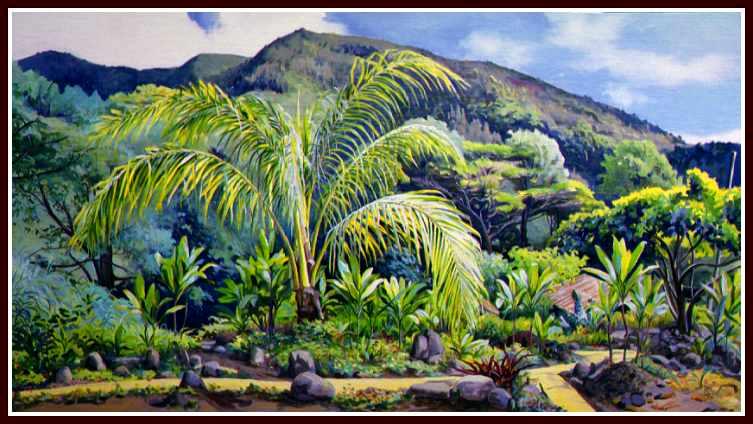Iao Valley Palm TreeOil on canvas, 26x48I really love painting in oils. This one brings back fond memories of a fun week in the Iao Valley, I sleep in my van. Good drying time makes oils easy to manipulate. Alkyd oil is like a drier in oil paints. Look how I simplified the area behind the tree on the left, keeping it down to three basic concentric rings around me. The foreground (ring 1), middle ground (ring 2) and the background (ring 6). Here is something on driers. Siccatives are metal salts soluble in oil. They speed the absorption of oxygen by the fatty oils, a two percent addition to paints is all that can safely be used because driers yellow more than oil. The addition of damar is a much safer practice, but that leaves you with two days drying time instead of one. Siccatives have been used for as long as mastic paints have been around, in the B/C era. Driers: Iron ore limonite is the cheapest most common element. - manganese siccatives - a green siccative that contained a copper resinate - sugar of lead was an early drier, it's called lead acetate. Today we use a cobalt oxide and limonite mix, to me the deep color purple is objectionable and I would rather have the clear sugar of lead or the white calcinated stannum oxide, like the Egyptian's used. Even white lead oxide could be heated and sponificated clear in oil and used as a drier. These are the sponificated (transparent) lead drying mediums, they were called malbutter, megilp, and Maroger. Made of heated oil, wax and lead, they worked very well. They added a buttery character to the paint, didn't yellow as much and were very popular. Many great masters like Van Eyck and Rembrant used lead siccatives. Bouguereau used heated lead (litharge), manganese salt and linseed oil or poppy oil. Never was this modern mixture of cobalt and iron used in the past. It's cheap and yellows too much. |
 |
PREVIOUS Painting with Tips Iao Valley Garden Steps